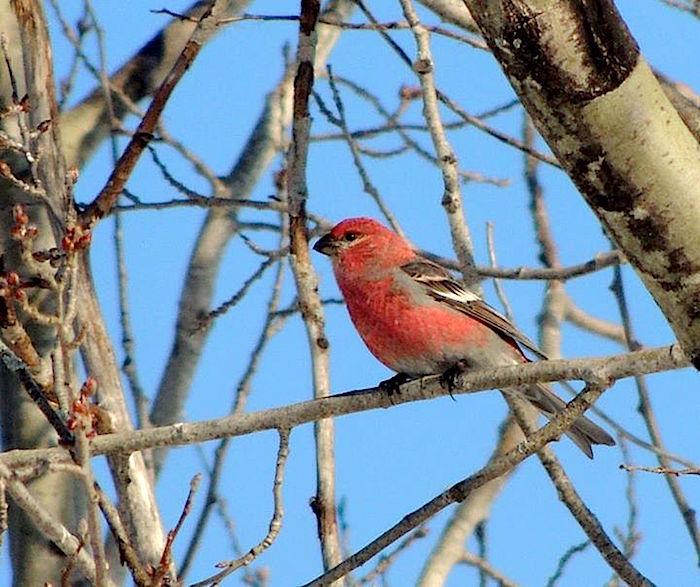
Where in the National Park System should you look for Pine Grosbeaks this winter?/Kirby Adams
Predicting the winter movements of semi-migratory birds can be tricky business. Sometimes birds move south because food has become scarce in the north, as was the case with Pine Siskins last winter. Other times, an abundance of food creates a hyper-successful breeding season that results in overpopulation and migration south. For that scenario reference the Snowy Owl irruptions of the last two winters. The easy ones are the cyclical migrants. Evening Grosbeaks tend to follow a biennial pattern, flowing south one winter and not the next. It takes a lot of study, some inside information, years of experience, and intuition to make good predictions.
Enter Ron Pittaway of the Ontario Field Ornithologists and his Winter Finch Forecast. The forecast has become an annual tradition that Pittaway offers free of charge to the birding community. Birders look forward to the release of the forecast every fall like celebrity-watchers anticipate the Academy Award nominees. Pittaway gleans his data from birders across Canada and contacts in the Ontario Ministry of Natural Resources and Forestry. Cone crops of pine and spruce all over Canada, seed crops of birch, and berry crops of Mountain-ash are all critically important to boreal finches.
The Winter Finch Forecast is technically a prediction for the birders of southern Ontario, but it’s proven to be accurate for much of the upper Midwest and northeastern United States. With a little extrapolation, its value extends west to the mountains and south to the Gulf. Pine Siskins made it almost all the way to the Everglades last winter after the forecast predicted some (but maybe not THAT much) southward movement. (They did get all the way there in 2009, with a half dozen seen on Snake Bight Trail in February of that year.)
What’s the hot news for this winter? It’s a mixed bag according to the Winter Finch Forecast.
Birch seed crops are less than spectacular across much of the north, so Common Redpolls should be moving south. Things look better on the birch in southern Ontario, but that doesn’t mean they’re all necessarily going to stop. Point Pelee National Park in Ontario is a great spot to see Redpolls when they head south. On the U.S. side of the border, Cape Cod National Seashore has produced some impressive flocks in winter.
Evening Grosbeaks seem to follow an alternating schedule of southerly flights from year to year in the Midwest. There were very few last year, so this would be an “on” year by that trend. There is also a strong outbreak of spruce budworms in Quebec, which the grosbeaks enjoy eating. The forecast predicted a small southward flight, and Evening Grosbeaks have already been showing up in better numbers than last year.
Pine Grosbeaks are a gigantic finch with a taste for berries. A below-average berry crop of Mountain-ash in the boreal forest may drive some of these spectacular birds south. One was reported in Cuyahoga Valley National Park in Ohio – 15 years before it was a national park – in the winter of 1985. Another 15 years later, perhaps they’ll host another.
A non-finch that gets covered by the finch forecast is the Red-breasted Nuthatch. It’s the northern counterpart to the larger and more widespread White-breasted Nuthatch. The news for lovers of these birds is poor this year. An abundant Balsam Fir crop is keeping them close to home. Birders in the south will just have to head to Great Smoky Mountain National Park where the high elevation hosts the nuthatches all year.
One charismatic bird that doesn’t get coverage in the Winter Finch Forecast is the Snowy Owl. After unprecedented back-to-back irruptive winters (and three irruptive winters out of the last four!), no one knows what to predict about Snowy Owls. There’s a bit of a hint, however, that’s turned up in the last few days. At least six Snowy Owls have appeared in Michigan’s Upper Peninsula since Saturday. That’s a lot of owls and it’s very early for them to be arriving. Cape Hatteras National Seashore had its own Snowy Owl in early 2014, and it might just happen again.
If finches were covered by the Las Vegas sports book, Ron Pittaway might be a billionaire, but until that happens we birders are delighted to have his annual forecast to give us something to look forward to. There’s nothing like a frisky flock of redpolls to take the bite out of a long winter. That and a trip to Canaveral National Seashore just to make sure no Snowy Owls have made it that far. Someone has to do it!



Add comment